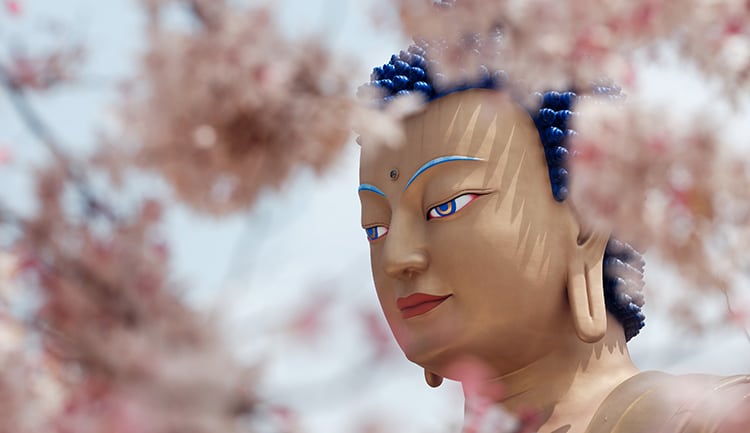The Psychology of Addiction
Category: Meditation and the Brain | Meditation for Addiction Recovery | Mind Trainer Articles | Popular

The intersection between modern trauma theory, addiction & mindfulness
The problem of addiction is not just a problem for people struggling with addiction. It’s a problem of the ages, and at one point or another, just about every person involved with addiction—especially those in recovery—comes to a point where he or she looks around and says, “I think everyone is an addict.”
I’ve been sober for 29 years now, and I had that moment in my early recovery. It was a long moment—probably about 6 months long. I wasn’t really welcome at parties at the time because I kept telling people, “You’re an addict, he’s an addict, everyone’s an addict.” But I think I was doing that because it’s true, insofar as modern, science-based psychology squares with what I understand the Buddha said a couple thousand years ago.
I’ve always seen the Buddha as a psychologist and a scientist. He undertook a seven-year single case study of himself. And after running through a bunch of different methods, he realized that some kind of middle way held the answer: then and there, he was starting to work on a pathway out of addiction. He sat down, thought about the process, and came up with insights that he formulated according to the medicine of the time in India.
What the Buddha did was give us a diagnosis. He outlined the symptoms and causes of addiction and outlined the cure. He offered a prescription. The core of the symptoms and causes revolves around themes that are central to the addictive process: the craving of pleasant things and pleasure, and the aversion to pain. In short, clinging and becoming attached. There was none of today’s scientific technology, but what he understood was that we don’t become addicted because we’re stupid or “less than”; we become addicted because we want to survive.
With addiction, the survival instinct (which is run by the reptilian brain and the paleomammalian brain) basically takes over and calls the shots, more than need be. The craving-clinging-aversion drama is simply a function of being human. If you boil it down to the psychology of the Buddha’s time (without the brain scanning equipment), what he noticed—and what we see today as well—is that when suffering, unsatisfactoriness and difficulties occur often enough, they reinforce each other and build into an increasing sense of what we might call “delusion,” or, if that’s too strong, an inability to see clearly.
In this regard, all human beings are walking through the addiction dilemma. One of the ways I like to phrase it is, “Everyone’s an addict, but we addicts do it better.” Everyone suffers, craves, clings and attaches, but oh man, we addicts are so good at it! For the addictive person, at a certain point the cravings are completely outside the realm of consciousness. It’s like being on automatic pilot.
I find it really remarkable that all the way back then, the Buddha taught that with the problem of addiction or intoxication, you find people quarreling, losing their wealth, exposing themselves, being out in the middle of the night with strangers, etc. It sounds like L.A. in 2018! But the most important issue, he said, is weakened insight. So the answer to addiction is developing insight and clarity through mindfulness and awareness practice.
How do you get away from addiction and into the realm of insight? It’s the same whether you’re an addict or not: it requires looking at things clearly and developing a way of seeing that allows you to affirm, “I’m going to start down this path,” whatever path it is that you believe will help. And it requires understanding how to live in a way that is not harmful to yourself or others, and developing a mindfulness practice.
This resonates with modern trauma theory or psychology. With brain scans and certain therapies that have been developed and are utilized every day, we’re seeing that lots of our problems—especially when it comes to addiction—consist of maladaptively processed memories that need to be brought to an adaptive resolution. To me, as a scientist, this is another way of saying that a whole bundle of suffering and difficulties and unsatisfactoriness is living in storage in the body—in the amygdala or basal ganglia—and we medicate it with our addictions. That bundle needs to be brought to the conscious neo-cortex so that we can have agency over it. It’s the whole mystery of how you can get through something that may have tortured you for years and finally arrive at a place where you can hear, “Yes, that happened, but it’s not happening now.”
Mindfulness, when practiced in a way that is trauma-informed, allows people who have been reacting to their traumas with maladaptive solutions to establish a place of safety. We let them know that they don’t have to sit for 20 or 30 or 60 minutes a day: five minutes is fabulous, and a five-minute practice every day is better than 30 minutes on Saturday and none the rest of the week. We explain that during practice, their minds are not supposed to “stop.” When someone sits for the first time, and they’re like, “My mind kept moving and I saw this and I heard that,” we say, “That’s good. And how are you now? We’ll try again tomorrow. Just notice what’s happening.”
Modern trauma theory around addiction says that if we don’t treat the trauma, we probably won’t treat the addiction. And so our task over the last 30 years in trauma research has been to find technologies that allow people to tolerate the memories, sensations and affects long enough to adaptively reprocess them. The idea is that the habitual level of suffering can end, just like what the Buddha said back in the day. We can change our relationship to our thoughts, we can change our relationship to our minds, we can change our relationship to our bodies. And that’s the prescription, that’s the cure.
It doesn’t make the pain of life go away. According to all the research I’ve done, that’s impossible. There’s always going to be old age, sickness and death; there’s always going to be my kids not wanting to go to school when I ask them to, and everything in between. Now, how am I going to relate to that? For someone who’s addicted, the immediate solution is to go to the addiction. Addiction treatment takes time. I’ve found that the best way to start that process is by simply sitting. Some people prefer silence, others prefer guided meditation, but either way, short, simple sitting helps build distress tolerance and get through the craving.
My personal meditation story is that I got sober in AA meetings in New York City. Four months into my addiction recovery, my best friend said he was going on an AA retreat. It sounded really corny. Then he said it was at a Zen Buddhist monastery, and that sounded awesome and weird, so off I went. I got my first “addiction meditation” lesson and I’ve been sitting ever since, including spending an entire year at that monastery nine years later.
During that first sitting, they rang the bell, and for the first couple of minutes I thought, “I think I might be the Buddha! Yeah, this is cool!” And then about three or four minutes later, I noticed that one knee had started to hurt, and then the other knee started to hurt, then my hips and my back, and then my mind started talking about things it hadn’t talked about for a while. I went into a mantra: you should ring the bell and end the session, you very mean person! And as this was a Zen place, they tended to not ring the bell soon enough.
That first sitting was about 50 minutes long. When they finally rang the bell, I was very relieved. I uttered a few expletives. And then I had the addict’s reaction: “Alright! When are we going to do that again?” I leveraged my addiction to build my practice.
Zen practice is so in the body—that’s where they point you, with very little instruction. What happened for me was I became able to tolerate a lot of stuff, until, at a certain point, I didn’t have to tolerate stuff anymore because it had already passed. Then the next unsatisfactoriness or suffering would come, and I would tolerate that and get through it. I built more and more experience just by sitting there. My first lesson was sit down, shut up, don’t move. It may not be gentle, but it worked for me.
For more from Dr. Stephen Dansiger check out his course on the Psychology of Addiction.
And here are additional articles related to addiction recovery by Mindworks:
- Forgiveness Meditation article by Joseph Rogers
- Article on Alcohol & Meditation






